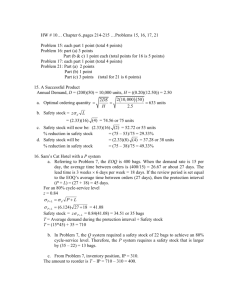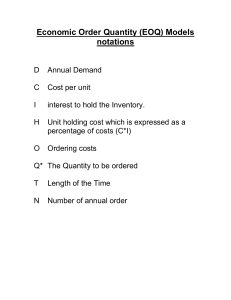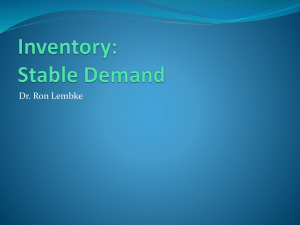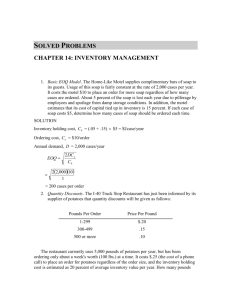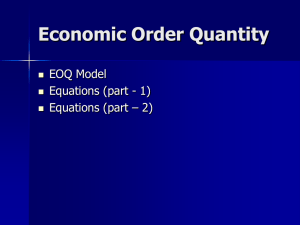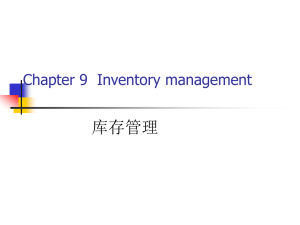inventory management through eoq model
advertisement
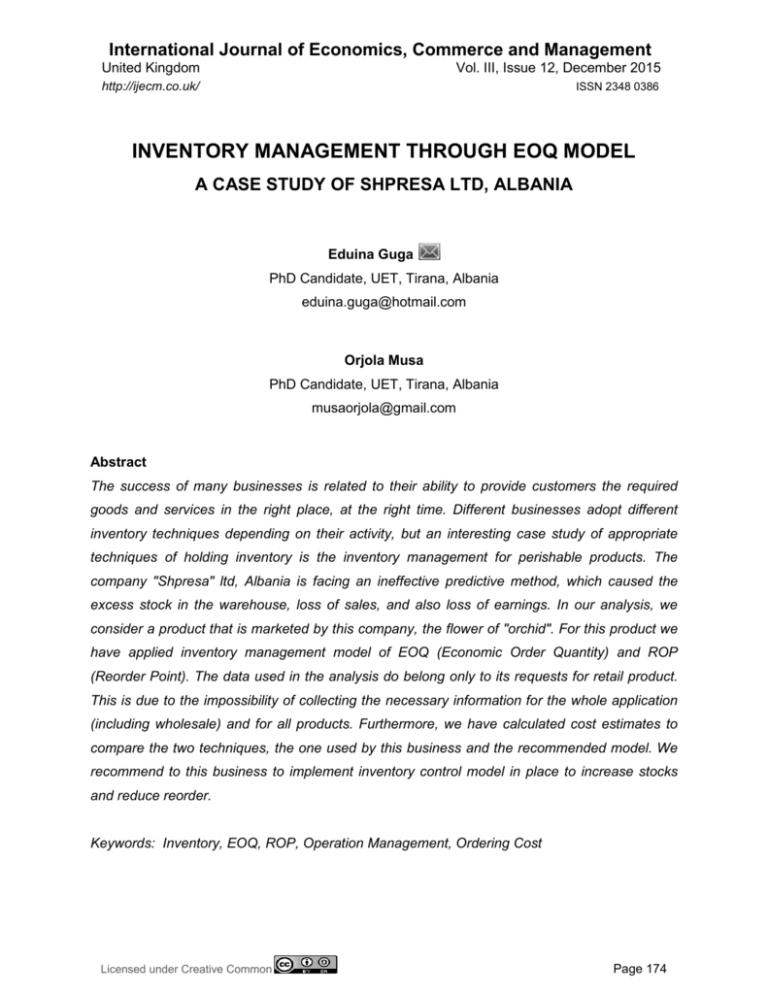
International Journal of Economics, Commerce and Management United Kingdom Vol. III, Issue 12, December 2015 http://ijecm.co.uk/ ISSN 2348 0386 INVENTORY MANAGEMENT THROUGH EOQ MODEL A CASE STUDY OF SHPRESA LTD, ALBANIA Eduina Guga PhD Candidate, UET, Tirana, Albania eduina.guga@hotmail.com Orjola Musa PhD Candidate, UET, Tirana, Albania musaorjola@gmail.com Abstract The success of many businesses is related to their ability to provide customers the required goods and services in the right place, at the right time. Different businesses adopt different inventory techniques depending on their activity, but an interesting case study of appropriate techniques of holding inventory is the inventory management for perishable products. The company "Shpresa" ltd, Albania is facing an ineffective predictive method, which caused the excess stock in the warehouse, loss of sales, and also loss of earnings. In our analysis, we consider a product that is marketed by this company, the flower of "orchid". For this product we have applied inventory management model of EOQ (Economic Order Quantity) and ROP (Reorder Point). The data used in the analysis do belong only to its requests for retail product. This is due to the impossibility of collecting the necessary information for the whole application (including wholesale) and for all products. Furthermore, we have calculated cost estimates to compare the two techniques, the one used by this business and the recommended model. We recommend to this business to implement inventory control model in place to increase stocks and reduce reorder. Keywords: Inventory, EOQ, ROP, Operation Management, Ordering Cost Licensed under Creative Common Page 174 International Journal of Economics, Commerce and Management, United Kingdom INTRODUCTION Origin of EOQ Formula Bill Roach explains how the origins of EOQ started in his article "Origin of the Economic Order Quantity fromula; transcription or transformation?", published in 2005. Roach explains that EOQ has been a well-known formula to calculate the optimal quantity of order. He also mentioned the important contribution that has given Ford Harris in the EOQ formula. He wrote the formula of economic order quantity in 1915, when he was still an undergraduate student. The formula of economic order quantity is used in the business field, also in the engineering. Students learned the engineering of the EOQ formula in economic engineering and industrial engineering courses. On the other hand, business disciplines studied in courses EOQ as a financial and operational management of inventory, so in both areas EOQ has practical application. Optimization of Economic Order Quantity In the article, “Optimizing Economic Order Quantity,” published by Dave Piasecki in 2001, focused on the economic order quantity. Piasecki mentions that in today’s leading technology, many companies are not taking advantage of the fundamental inventory models. There are various software packages in aiding companies with inventory control, but if the data inputted are inaccurate, it may lead to poor results. (Piasecki 2001) In order to have suitable results for any inventory model, accurate product costs, activity costs, forecasts, history, and lead times need to be in place. (Piasecki 2001) As a result of bad data, companies have had bad experience with some inventory models, and that is one of the reasons they do not take advantage of the EOQ model. Piasecki also explains that another reason why a company does not take advantage of the EOQ model is because management does not know how it works. (Piasecki 2001) Even if a company has implemented a leading software package to help them, if they do not know how the system works it could cost more harm than good. Many times the users do not understand how the data is calculated and how the system is set up. They simply rely on the system built-in default software calculations, which in most cases, the system is “out of whack”. (Piasecki 2001) In order to prevent the system from going “out of whack,” management as well as the user, need to obtain proper knowledge of the EOQ concepts and how they are derived. The software is only design to aid and not replace the traditional way of running a business. EOQ Formula At times, people in the retail business or in the manufacturing industry do not know or do not understand what EOQ stands for and how it is used? In this article, “The EOQ Inventory Licensed under Creative Common Page 175 © Eduina & Orjola Formula,” written by James A. Cargal clearly explains the fundamental theory of the Economic Order Quantity. Cargal published this article from Troy State University Montgomery. The article is straight forward and easy to understand. Cargal does a great job explaining each variable and how it’s used accordingly. The formula is written as illustrated in equation 1 and described as the following: 2∗𝐷∗𝑆 𝐻∗𝐶 𝑄=√ (EQ: 1) Q= the EOQ order quantity. This is the variable we want to optimize. All the other variables are fixed quantities. D= the annual demand of product in quantity per unit time. This can also be known as a rate. S= the product order cost. This is the flat fee charged for making any order and is independent of Q. C=Unit cost. H= Holding cost per unit as a fraction of product cost. Figure 1: EOQ Process Graph Assumptions of the EOQ EOQ model assumes that demand is constant, and that poor inventory at a fixed rate until it reaches zero. 1. The firm knows with certainty how much items of particular inventories will be used or demanded for within a specific period of time. 2. The use of inventories or sales made by the firm remains constant or unchanged throughout the period. Licensed under Creative Common Page 176 International Journal of Economics, Commerce and Management, United Kingdom 3. The moment inventories reach to the zero level, the order of the replenishment of inventory is placed without delay. 4. The above assumptions are also called as limitations of EOQ model. Calculation of EOQ It determines the optimal amount of those costs that affected both by the amount of inventories held and the number of orders made. Ordering in bulk at the same time will increase the costs of maintaining a small business, because that will increase the number of stocks in the warehouse, while ordering costs will be lowered. Increasing the number of orders reduces holding costs but increases the costs of ordering. EOQ model finds that minimizes the amount of these costs. Economic order quantity found a formula that shows the connections between the costs of maintaining and ordering and annual demand for material. CASE STUDY: “SHPRESA” LTD "Shpresa” Ltd has started its activity in 1992, in the small town of Permeti, where the main activity was cleaning and Greening the City, and Maintenance of Public Cemetery. Further, in 1998 the activity has moved to Tirana. Now "Shpresa” deals with: Reconstruction, Construction, Cleaning, Greening, Maintenance and Food public entities, such as hospitals, catering and Urban Design etc. One of the activities of "Hope Ltd" is the marketing of natural flowers, which supply in the Netherlands and sells in Albania. It carries out wholesale sales to 80% of retail points in Tirana, and also distributes in the cities of Shkodra, Lezha, Elbasan and Durres. Apart from wholesale sales, this company carries out retail sales. Due to the inability of the collection of data for all activity, inventory analysis have applied only to retail sales. In the existing business environment, companies have no chance if they are not doing a cost effective management, and therefore, if you do not maintain an appropriate model for inventory control. Model quantity economic order, and the reorder point (EOQ / ROP) have been used for many years, but some companies still have not gained advantages from it. An EOQ model assists in the decision about which would be the optimum quantity of order, that the company provide the lowest cost possible. As EOQ-behold, the reorder point, advises when to be made the reorder for specific products, based on historical demand. The reorder point also allows the necessary quantity of the stock to enable the completion of the request, while the other order is coming. Since sales are unpredictable, and due to the competition, interest to see how the forecast affects EOQ and ROP made that "Shpresa Ltd" society to seek alternative methods for solving the question of forecasting. Licensed under Creative Common Page 177 © Eduina & Orjola The central question of this study is to recommend an economic analysis for the quantity and reorder point for the society in question. The Problem Current forecasting model used by "Shpresa Ltd" has brought some problems due to inaccurate forecasting, which has resulted in the further expected and damaged, and loss of sales. Forecasting method used is the simple average, ie estimated average requirements (future) based on average historical demand, but this has led to inaccurate predictions. The purpose of this project is to recommend alternative ways to help the company to reduce the stock, using a more effective prediction by EOQ and ROP. For this purpose, we analyse a product of this society, using the data of the last four years. Finallywe will estimate the cost to see the importance and difference compared to the current model. Application of EOQ model to "Shpresa" sh.pk Significant and Irrelevant cost Significant Costs Significant Costs affecting the determination of the optimal inventory levels are the holding costs and ordering costs. Significant holding costs are only those that differ with respect to inventory levels. This includes the opportunity cost of holding funds invested in stocks, which is reflected by the lost of wanted return from investing in stocks compared with any other investment alternative. For our firm the required return is 25%. In other holding costs it is included electricity used for lighting of flowers and refrigerating equipments. Society pays 20,000 ALL per month for electricity, and taking the exchange rate 140, the cost of electricity goes to € 1,714 for 12 months. In ordering costs there are included costs for transportation and telephone , which relate to the number of units ordered. "Shpresa" Ltd Society makes a supply once every two months and the charge is € 15,000. Society pays 10,000 ALL per month for phone expenses, and taking the exchange rate 140, the phone costs go to € 857 per year. Irrelevant costs Irrelevant costs include those costs that are not affected by changes in the levels of inventories, such as employee salaries, depreciation of equipment, fixed rent of equipment and buildings etc. Licensed under Creative Common Page 178 International Journal of Economics, Commerce and Management, United Kingdom Shpresa Ltd estimates as insignificant cost 1. Employee wages, which go to 150,000 ALL per month. They reach a total of € 12,857 per year. 150.000 leke⁄muaj × 12 muaj = 12.857€ 140 leke⁄€ 2. Depreciation The firm calculates 3% depreciation per year for building and refrigerator. The value of the building is 200,000 €, while the value of the refrigerator is € 25,000. Annual depreciation for the building: 200000€ × 3% = 6.000€ Annual depreciation for the fridge: 25000€ × 3% = 750€ Determination of EOQ Economic Order of Quantity EOQ can be determined reflecting the total costs for different amounts of orders via three methods: the formula, tables and graphical representation. For the EOQ's determination we need the annual demand data, the cost of ordering and cost of holding. In this paper we supposed to calculate EOQ for the flower "Orchid" which is sold in vases. 1. “Shpresa” Ltd calculates annual demand for orchid, based on average monthly turnover. It works 365 days a year. So the annual demand for orchid is: D = 100 Vase⁄Mounth × 12 = 1.200 Vase⁄Year 2. The purchase price for one unit is 8.5 €⁄Unit P = 8.5 €⁄Vase 3. Company investment in stocks requires an annual return of 25%. 4. Ordering Cost These include the costs of transport and telephone. The company makes a supply 1 time in 2 months and the charge is € 4,000. According to the company, the specific weight of the flowers that "orchid" take in a supply of 15,000€, is 5%. So, in a supply of 15,000€, 750€ cost only for orchid pots. As a vase costs 8.5 €, then we Purchase approximately 88 vases of orchid. 𝑁𝑜 𝑜𝑓 𝑉𝑎𝑧𝑒𝑠 = 750€ ≅ 88𝑣𝑎𝑧𝑒 8.5 €⁄𝑣𝑎𝑧𝑒 The firm makes 6 orders per year. Cost of ordering for orchids: 𝑇𝑟𝑎𝑛𝑠𝑝𝑜𝑟𝑡𝑖𝑡 𝐶𝑜𝑠𝑡 = Licensed under Creative Common 4.000€ × 0.05 × 6 = 13.6𝑒 88𝑣𝑎𝑧𝑒 Page 179 © Eduina & Orjola 𝑇𝑒𝑙𝑒𝑝ℎ𝑜𝑛𝑒 𝐶𝑜𝑠𝑡 = 857€ × 0.05 = 0.48€/𝑣𝑎𝑧𝑒 88𝑣𝑎𝑧𝑒 𝑂𝑟𝑑𝑒𝑟𝑖𝑛𝑔 𝐶𝑜𝑠𝑡 = 14.08 €⁄𝑣𝑎𝑧𝑒 5. Ordering Cost After determining the costs we can estimate EOQ by 3 methods. The Formula Method 2×𝐷×𝑆 𝐸𝑂𝑄 = √ 𝐻 For vases of orchid the economic order quantity is: 2 × 1200 × 14.08 𝐸𝑂𝑄 = √ = 128𝑣𝑎𝑧𝑜 2.06 So, the economic order for the orchid vases is approximately 128 vases per order. Since the firm currently orders 88 vases, it should increase the amount of the order for up to 128 orchids vases, in order to minimize costs. The Method of Tabulation We list the significant annual costs for different order quantities. The purpose of this method is to find which amounts significant annual total costs are minimal. In the level of 128orchids vases, the level of total significant costs are lower than for other ordering quantities, at the value of € 263.84. Table 1: EOQ through Tabulation Method The quantity of order 80 90 100 128 130 150 Avverage stock in units 40 45 50 64 65 75 No of purchase orders 15 13.33 12 9.375 9.2308 8 Annual holding Cost 82.4 92.7 103 131.84 133.9 154.5 Annual Ordering Cost 211.2 187.733 168.96 132 129.97 112.64 Total Significant Cost 293.6 280.433 271.96 263.84 263.869 267.14 Graphical Method According to the graphical method, economic order quantity is found at the point where the cost of holding is equal to the cost of ordering . So EOQ point is found where these curves intersect one another. For the orchid flower the curveof holding costs is crossed with the ordering curve at the value of € 132 and the amount of 128 units, which is the optimal order quantity. Licensed under Creative Common Page 180 International Journal of Economics, Commerce and Management, United Kingdom Figure 2: EOQ through Graphical Method Reordering Point The delivery time for “Shpresa” Ltd is 2 weeks. This amount of time is considered as the most significant interval and includes the moment when the order is made and the moment when the order is delivered. For Orchids the Economic Order of Quantity is 128 units per order. Since the annual demand is 1200 units, then the firm should make approximately 9 orders in a year. The firm works 52 weeks a year, so the order should be made approximately every 6 weeks. The weekly usage of orchids is calculated dividing the annual demand with the number of the weeks the firm works in a year. 1200⁄52 ≅ 23 𝑢𝑛𝑖𝑡𝑠⁄𝑤𝑒𝑒𝑘𝑠. Reorder Point for Orchids Figure 3- Reorder Point for Orchids Since the most significant interval is two weeks then the firm should make an order when the stock level is at 92 orchid vases. Licensed under Creative Common Page 181 © Eduina & Orjola DISCUSSIONS AND CONCLUSION The use of the EOQ model in inventory management for "Shpresa Ltd" will result in reduction of the cost of ordering and inventory holding costs, and as a result, the reduction of the total cost. Although this method cannot be fully adaptable by this company due to the distance with the place of supply, and limited opportunities for frequent reorders. As we see, this method requires the Company to make reorders for orchids every 6 weeks, and the company actually makes an order every 8 weeks due to the remoteness of the supplier country. A further limitation to the adoption of this method is the use of incomplete information, in relation to products, as in the analysis made, we consider only the flower of the orchid, which is sold in vase, while this firm trades a variety of products for which will result in a different reorder point for these products. Also other important variables, such as annual demand for wholesale were left out of the analysis. As a conclusion we can argue that this model is perfect theoretically, but not very suitable from the practical perspective of this firm. REFERENCES Balakrishnan, Anantaram., Pangburn, Michael S., and Stavrulaki, Euthemia. ""Stack Them High, Let 'em Fly": Lot-Sizing Policies When Inventories Stimulate Demand. " Management Science 50.5 (2004): 630644. ABI/INFORM Global, ProQuest. Web. 10 Dec. 2009. Bassin, William M. "A Technique for Applying EOQ Models to Retail Cycle Stock Inventories. " Journal of Small Business Management 28.1 (1990): 48- 55. ABI/INFORM Global, ProQuest. Web. 10 Dec. 2009. Cargal, James M. "The EOQ Inventory Formula." http://www.cargalmathbooks.com. Web. 15 Nov. 2009. <http://www.cargalmathbooks.com/The%20EOQ%20Formula.pdf>. Carter, Joseph, Bruce Ferrin, and Craig Carter. "On Extending Russell and Krajewski's Algorithm for Economic Purchase Order Quantities." Decision Sciences, 26.6 (1995): 819. Chen, Fangruo. "Echelon Reorder Points, Installation Reorder Points, and the Value of Centralized Demand Information." Management Science, 44.12 (1998): 221. Piasecki, Dave. "Optimizing economic order quantity." IIE Solutions 33.1 (2001): 30. Academic Search Elite. Web. 19 Nov. 2009. <http://search.ebscohost.com/login.aspx?direct=true&db=afh&AN=4770913&site= ehost-live>. Roach/School of Business, Washburn University, Topeka, Kansas, USA, Bill. "Origin of the Economic Order Quantity formula; transcription or transformation?" Management Decision 43.9 (2005): 1262-268. Emerald Group Publishing Limited. Web. 20 Nov. 2009. <http://http://www.emeraldinsight.com/Insight/ViewContentServlet?Filename=Published/EmeraldFullText Article/Articles/0010430911.html>. Stockton, David John, and Liam Quinn. "Identifying Economic Order Quantities Using Genetic Algorithms." International Journal of Operations & Production Management, 13.1993 (1993): 92. Licensed under Creative Common Page 182
